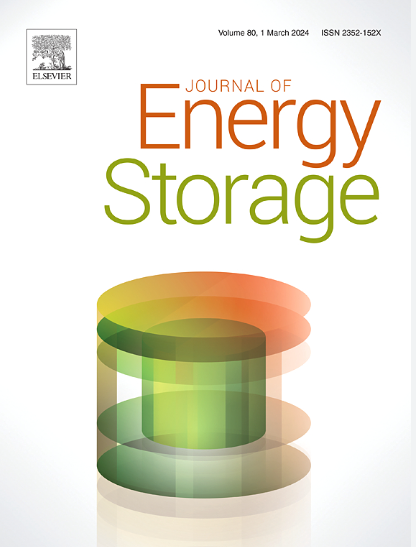盐水合物堆积颗粒床中的水化前沿II:温度梯度的作用及其对储热的影响
IF 8.9
2区 工程技术
Q1 ENERGY & FUELS
引用次数: 0
摘要
基于盐水合物颗粒的热化学储能(TCES)有望在建筑环境中实现紧凑的长期储热。利用盐水合物的水化转变,来自气相的水分子被纳入盐的晶格中,导致热量输出。本研究的目的是开发一个易于使用的分析模型,用于TCES反应器内毫米大小的盐颗粒床的水化过程,该模型同时描述了床中的水蒸气浓度分布、转化曲线和温度梯度。该模型是先前开发的水化锋等温模型的扩展。该模型描述了水蒸气向水化锋的平流输送,在那里水蒸气与盐颗粒发生反应。粒子内部的反应是受扩散限制的。得到了水化锋面沿颗粒床运动的解析解:锋面速度和宽度。结果表明,温度梯度显著减缓了水化前缘的运动,减小了水化前缘的宽度。在与TCES相关的条件下,盐水合物颗粒的前宽约为数十厘米,这与目前研究的TCES反应器的典型尺寸相当。只有当水化前缘在反应器内移动时,它才会以较高的恒定功率排出。因此,这些电抗器将有一个短的恒功率阶段(CPP),而大多数放电发生在所谓的下降功率阶段(FPP),在这个阶段,功率不断下降,输出温度也在下降。模型表明,增加反应器长度、减小流速或减小粒径均可延长CPP相。该模型使工程师能够对TCES反应堆的首次设计进行快速计算。本文章由计算机程序翻译,如有差异,请以英文原文为准。
Hydration fronts in packed particle beds of salt hydrates II: The role of temperature gradients and implications for heat storage
Thermo-Chemical Energy Storage (TCES) based on salt hydrate particles is promising for compact long term heat storage in the built environment. The hydration transition of salt hydrates is used, where water molecules from the gas phase are incorporated in the crystal lattice of the salt, resulting in heat output. The aim of this study was to develop an easy-to-use analytical model for the hydration process of a bed of millimetre sized salt particles inside a TCES reactor, which describes simultaneously the water vapour concentration distribution, the conversion profiles and temperature gradients in the bed. The model is an extension of a previously developed isothermal model for hydration fronts. The model describes advective transport of water vapour towards the hydration front, where the water vapour reacts with the salt particles. This reaction inside particles is diffusion limited. Analytical solutions have been obtained for the hydration front travelling through the particle bed: the front velocity and width. We show that temperature gradients significantly slow down the motion of the hydration front and reduce the width of the front. Front widths for salt hydrate particles under conditions relevant for TCES are of the order of tens of centimeters, which is comparable to the typical size of presently studied TCES reactors. Only when the hydration front is travelling inside the reactor, it will be discharged at a high constant power. Therefore, these reactors will have a short constant power phase (CPP), while most of the discharge happens in the so-called falling power phase (FPP), where the power is continuously dropping and the output temperature too. The model shows that the CPP phase can be prolonged by either increasing the reactor length, decreasing the flow rate or decreasing the particle size. The model enables engineers to do quick calculations for the first design of a TCES reactor.
求助全文
通过发布文献求助,成功后即可免费获取论文全文。
去求助
来源期刊

Journal of energy storage
Energy-Renewable Energy, Sustainability and the Environment
CiteScore
11.80
自引率
24.50%
发文量
2262
审稿时长
69 days
期刊介绍:
Journal of energy storage focusses on all aspects of energy storage, in particular systems integration, electric grid integration, modelling and analysis, novel energy storage technologies, sizing and management strategies, business models for operation of storage systems and energy storage developments worldwide.
 求助内容:
求助内容: 应助结果提醒方式:
应助结果提醒方式:


